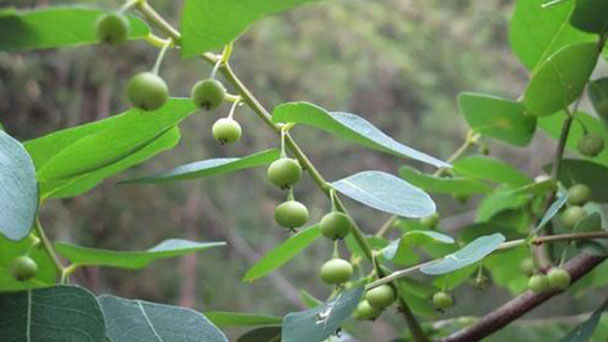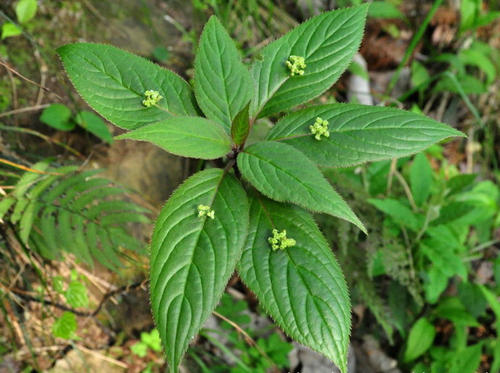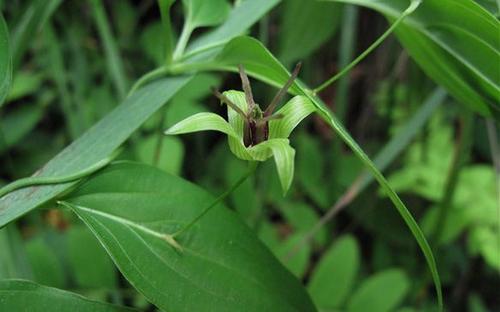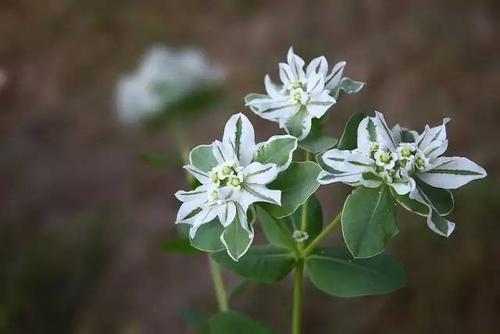Japanese helwingia (Helwingia japonica) profile
Written by Maggie
Mar 02 2021

Japanese Helwingia (Latin name: Helwingia japonica (Thunb.) Dietr.) is a deciduous shrub in the Cornus family, with a height of up to 2 m. Japanese Helwingia leaves are papery, ovate, ovoid, sparsely elliptic, apex acuminate, very few apex caudate acuminate, base broadly cuneate or nearly round, margin spiniform serrulate; Flowering in early summer, dioecious, small, yellow-green flowers, in the center of the main veins on the leaf.
Japanese helwingia picture

Morphological characteristics of Japanese helwingia
Japanese helwingia is a deciduous shrub, 1-2 m tall; Young shoots are green, glabrous, leaf marks marked. Leaves are papery, ovate, ovoid, sparsely elliptic, 3.5-9 (-18) cm long, 2-6(-8.5) cm wide, apically acuminate, very sparsely caudate acuminate, base broadly cuneate or nearly orbicular, margin spiniform serrulate; Leaves of Japanese Helwingia are bright green above, light green below; Midvein and lateral veins are slightly concave above, slightly protruding below; Petiole is 1-5(-6) cm long; Stipules are linearly divided.
Flowers of Japanese Helwingia are pale green, 3-5, calyx small, petals 1-2 mm long, valvate; Japanese Helwingia has 4-12 male flowers, umbellate or densely cymbose, often in the upper middle vein of leaves at 1/2-1/3, rarely in the upper part of young branches; Pedicels are 1-2.5 mm long; Japanese Helwingia has 3-5 stamens, on medial disc; Japanese Helwingia has 1-3 female flowers, borne on 1/2-1/3 of upper midvein of leaves; Pedicels are 1-5 mm long; Ovary is ovoid or globose, stigma 3-5-lobed. Berries are green when young, black when mature, 3-5 nuclei.
Ecological habits of Japanese helwingia
Japanese Helwingia was often born in the elevation of 3300 meters below the forest, like wet and fertile soil. During the growing period, they like a damp and cool environment, and they require forest soil with high humus content, and avoid high temperature and dry climate.
Distribution of Japanese helwingia
Japanese Helwingia is widely distributed in the southern provinces of the Yellow River Basin in China. It is also found in Japan, northern Burma and northern India.
Japanese Helwingia propagation
Japanese helwingia can be propagated by seed seeding or cuttings.When the seeds mature in autumn, the collected fruits will be mashed flesh, repeatedly rinse with water, take out the seeds, dry in the shade. It can be picked and sown at any time, or it can be stored and planted in a pot or ground with the next spring. Placement is suitable for the selection of leeward shade, fertile soil and good drainage plots. Cuttage can choose 1-2 years of branches, cut growth 6-12 cm bud cuttings, in autumn or spring. And pay attention to cover moisture, improve its survival rate.

Species taxonomy of Japanese helwingia
Japanese Helwingia (Varieties) (Phytotaxonomica Sinica)
Helwingiajaponica(Thunb.)Dietr.subsp.japonicavar.hypoleucaHemsl.exRehd.
The difference between this variety and the original variety is that the underleaf is pinkish white, often grayish white or pinkish green. Produced in southern shaanxi, western hubei, sichuan, northern guizhou, northeast yunnan. It is usually born at an altitude of 1240-2800 m. The type specimens were collected from western Hubei Province.
Japanese Helwingia (Varieties) from Sichuan (Plant Taxonomy)
Helwingiajaponica(Thunb.) Dietr.subsp.japonicavar.szechuanensis(Fang) Fanget Soong
The leaves of this variety are usually nearly round or ovate-elliptic, the base is round, sparse and shallow cordate, and the base of the leaves is often downward. The fruit is born in the middle of the midvein of the leaf, but the apex of the leaf is blunt and round or hollow, and the fruit is born in the middle or above the middle of the midvein of the leaf. It is produced in western sichuan. They are often found in forests at an altitude of 1900-2600 meters. The type specimens were collected from Mount Emei, Sichuan.
Japanese helwingia (variety) (sichuan flora)
Helwingiajaponica(Thunb.) Dietr.subsp.japonicavar.griseaFanget Soong
The leaves of this variety are nearly ovate or ovate-elliptic, 7 -- 11 cm long and 3.5 -- 4.5 cm wide, gray below, slightly pinkish, margin obtuse and rounded serrate. Japanese Helwingia is made in Sichuan, China.They are commonly found in thickets at an altitude of 1200-2300 m. The type specimens were collected from Guanxian County, Sichuan Province.
It is very similar to white Japanese helwingia, but easily distinguishable from this variety in leaf shape and serrated margins.
Japanese Helwingia (Variant) (Flora of Sichuan)
Helwingiajaponica(Thunb.)Dietr.subsp.japonicavar.papillosaFanget Soong
The difference between this variety and other varieties is that there are white papillae on the lower midvein and lateral veins of the leaves, and there is only one fruit on the upper midvein of the leaves, with 4-5 cleft stigma and 4-5 nucleation at the apex. It is produced in southern shaanxi, southeast gansu, sichuan and southeast Xizang.Often in the elevation of 2100-3300 m forest, hemlock or fir forest distribution is more. The type specimens were collected from Hongya County, Sichuan Province.
Japanese helwingia (subspecies) from Taiwan (Journal of Sichuan University)
Helwingiajaponica(Thunb.) Dietr.subsp.formosana(Kan.et Sas.) Haraet Kuros
The subspecies is distinguished from the proto-subspecies in that the leaves are oblong, thinly lanceolate, 5-12 cm long and 1.5-6 cm wide.
It is produced in southern Zhejiang and Taiwan, China. They are commonly found at an altitude of 1700-2500 m.
Japanese helwingia main value
Watch
Spring is the flowering season for Japanese helwingia, when small flowers bloom on the pages. By early summer, the pages begin to produce one to three small green fruits that, when ripe in autumn, will turn black, like bright black gems set on emerald green pages. Exotic sights make visitors stop to admire and marvel at the colorful and magical world of plants.
Medical value
Japanese Helwingia can activate blood circulation, remove blood stasis, clear heat and detoxify. Japanese Helwingia is used for edema, urination pain, urination pain, less milk or not.
Japanese Helwingia leaves can clear heat and dehumidify.Used for blood stool. Fruit: Used for stomach ache.

Latest Updated
- Benefits of Bugleweed - 7 Science-backed Health Benefits
- Bugleweed Dangers & Side Effects - Is It Poisonous?
- How to Plant Evergreen Trees - What You Should Know
- When to Plant Evergreens - Grow Guide for Evergreen Trees
- 12 Wonderful Evergreen Shrubs for Your Garden
- 12 Popular Evergreen Plants with Pictures for Beginners
- When And How To Prune A Lilac Bush Like a Pro
- How to Grow & Care for Lilac Vine (Hardenbergia Violacea)
- Japanese Lilac Tree (Syringa Reticulata) Care & Propagation Guide
- Shumard Oak Pros and Cons - What to Know
Popular Articles
- Winter maintenance of Antirrhinum Majus
- How to Grow Terminalia Mantaly Tree
- How to Grow and Care for Crossostephium Chinense
- How to grow Antirrhinum Majus in spring
- Peristeria Elata (Dove Orchid) Profile: Info & Care Guide
- Underwatered Snake Plant (Sansevieria Trifasciata) - Signs And How To Fix
- How to Care for Brazilian Jasmine Plant (Mandevilla Sanderi)
- How to Grow & Care for Graptopetalum Purple Delight in Summer
- Rosa Chinensis (China Rose): Plant Growing & Care Tips
- How to Care for Baby Sun Rose (Aptenia Cordifolia)